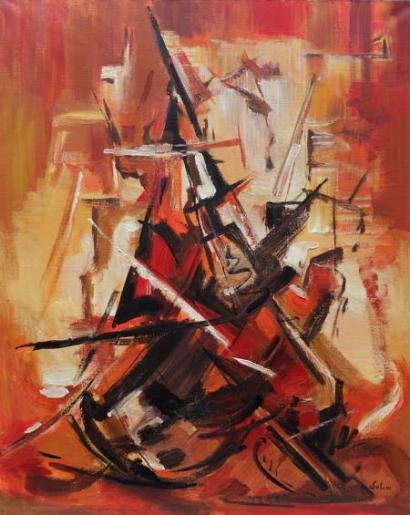Indeed, throughout history, the itinerary between Paris and Istanbul was the one of all exchanges and confrontations: it was at different times the road to the extension of Christianity, the tip of the Silk Road, an opening to invasions, and, in the other sense, the road of the crusades, the first segment of Chateaubriand’s itinerary to Jerusalem, as well as the educational one of the mandatory “Grand Tour” for Europe’s aristocratic youth.
This luxury train started its service in 1883, exploiting this fascination for the Golden Horn, and rode over the hazards of history, as it only stopped serving in time of war. Consequently it picked up again in 1945, and once again offered daily departures as of 1947. The inconveniences due to the Iron Curtain, and the development of the plane were a final blow, and the train disappeared in 1977. Obviously, artists did not travel among Prou’s furniture, or next to Lalique’s glass panels. No, actually they came from those regions to reinforce the second Ecole de Paris, carried by something quite different from luxury and pleasures:
“Some arrived because they were Jewish, and no Jews were wanted in their countries. But others came for reasons that had nothing to do with that ‘force majeur’, and simply because, in the past, Van Gogh had needed the light of France and because the most surprising inventions in art, […] had occurred in France.” (Jean Cassou, Une vie pour la liberté, 1981)
These words describe the first wave of the Ecole de Paris. As for the period after the Second World War, and the Cold War, it could be said: “Some arrived because they were not communist, etc.” And all the words regarding the attraction of artists to Paris at the time remain valid. 1945-1977: that is the period that covers the one of the second Ecole de Paris, and which serves as the frame of the dates of the works the gallery exhibits, by artists from the various stops the Orient Express made according to the changes in its itineraries: Vienna, Budapest, Bucharest, Sofia, and –last but not least-, Istanbul. This exhibition wishes to pay tribute to some of them.
Focus on four Turkish artists
Abidin Dino (1913-1993)
Next to Fikret Moualla, and later Dogançay, the founder of the “D Group” which opened the era of modern painting in Turkey. A scenographer in various movie studios, he directed the movie “Miners” in Moscow, Kiev, and Odessa. In Paris, from 1937 to 1939, he met Gertrude Stein, Tristan Tzara, and Picasso. In 1941, due to martial law, he exiled to the South East of Anatolia. He came back to Paris in 1953, where the Dino family’s home became the meeting place for many famous artists and writers. The couple set up in the studio on the last floor of Max Ernst’s apartment, on quai Saint-Michel.
Selim Turan (1915-1994)
A student at the Arts Academy in Istanbul, where he learned Turkish decorative arts, and calligraphy. He graduated in 1941, and was awarded the first prize in painting of Ankara. He was close to Abidin Dino, accompanied him to the Soviet Union as of 1941, to the “Houses of the People”, and received an award. In 1947, thanks to a scholarship from the French government, he settled in Paris. He produced poetic non-figurative works, based on a sober range of browns and greys. He took part in the fair of Réalités nouvelles, the fair of Mai, and that of Comparaisons. He taught at the academies of Ranson and Goetz, produced marble sculptures, and mobiles. In the 50s, personal exhibitions at Iris Clert or Claude Bernard galeries.
Orhon Mubin (1924-1981)
Arrived in Paris in 1947 to study political science courses at the Sorbonne, he discovered the cultural effervescence of the post-war era, took drawing lessons, met artists such as Poliakoff, Messagier, Atlan. With some of them he participated in the Salon des Réalités nouvelles and the one of Mai. Through his research he became close to the movement of informal art and lyric abstraction. In 1956, his first personal exhibition at the Galerie Iris Clert, followed by international exhibitions in Europe, Turkey, the USA, Brazil, and other sites. Between 1964 and 1973, returned to Turkey before settling permanently in Paris, where he died in 1981
Erdal Alantar (1932-2014) .
Alantar was a citizen of the Bosphorus, a great swimmer, and such a music lover that he used to paint while listening to classical music played at full volume. He “so loved painting, that when he perspired he had the impression his perspiration was in color”. Arrived in 1958 in France, the “source” of abstract art in his time. In the 60s, he worked at a plant that subcontracted to Renault, and always kept a strong commitment towards workers. His painting indicates his double culture: through his gestural abstraction very typical in France in the period following the Second World War, one senses the heritage of Ottoman calligraphy, magnified by the attraction liquids exerted on the artist.
To see another illustration, click on Version Française, at the top of the page
|









